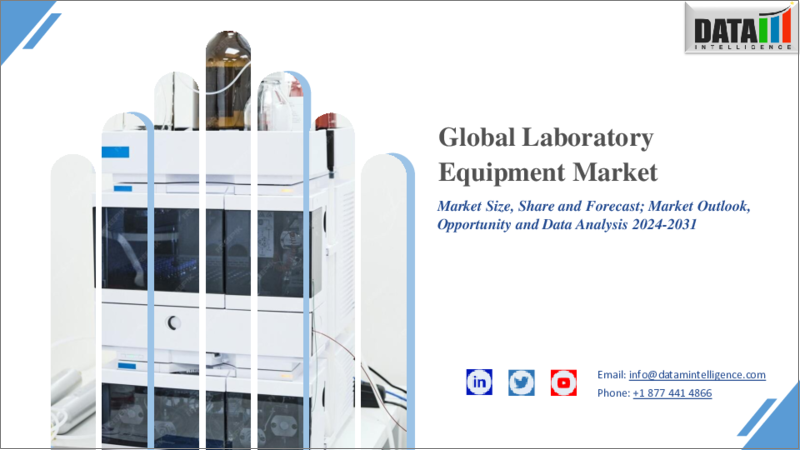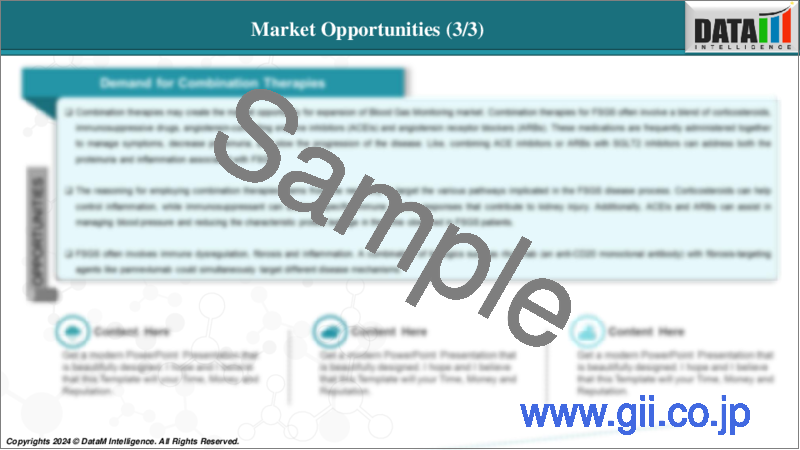|
|
市場調査レポート
商品コード
1606517
臨床検査機器の世界市場-2024~2031年Global Laboratory Equipment Market - 2024-2031 |
||||||
カスタマイズ可能
適宜更新あり
|
|||||||
| 臨床検査機器の世界市場-2024~2031年 |
|
出版日: 2024年12月04日
発行: DataM Intelligence
ページ情報: 英文 176 Pages
納期: 即日から翌営業日
|
- 全表示
- 概要
- 目次
概要
臨床検査機器の世界市場は、2023年に531億米ドルに達し、2031年には961億米ドルに達し、予測期間2024年にはCAGR 7.7%で成長すると予測されています。
臨床検査機器は、科学研究所で実験、分析、様々な分野の研究をサポートするために使用される多様なツールやデバイスを包括しています。これらの機器は、正確な測定を保証し、制御された条件を維持し、多様な科学的試みを促進するために極めて重要です。臨床検査機器は研究室の要求によって大きく異なるかもしれません。臨床検査機器は、診断、治療、研究を支えるヘルスケア企業にとって不可欠なものです。臨床検査機器は、医療従事者が患者の状況を把握し、健康状態を把握し、治療戦略を立案するための様々なアセスメントを行うために必要不可欠な機器です。臨床検査機器は、基本的な血液検査から複雑な遺伝子診断に至るまで、患者のケアに不可欠な医療介入を正確かつ迅速に行います。
予測期間中、市場を牽引するのは技術的進歩です。例えば、Edinburgh Instruments社は蛍光分光器と紫外可視吸収分光器を発売しました。IR5は最新の高性能ベンチトップFTIR装置であり、第二検出器やフーリエ変換フォトルミネッセンス(FT-PL)機能付きで構成することができます。
市場力学:
促進要因と阻害要因
技術的進歩
技術の進歩は、世界の臨床検査機器市場の成長において重要な要因となることが予想されます。技術の進歩は、世界の臨床検査機器市場の拡大に大きく影響し、ラボの運営を根本的に変え、その能力を増強します。自動化、人工知能、クラウドコンピューティングを含む先進技術の導入は、ラボの手順を変革し、その効率と精度を高めています。研究室がこれらの技術を徐々に利用することで、業務を最適化し、人的ミスを最小限に抑え、研究結果の全体的な質を高めることができます。
現代の研究室における根本的な変革は、自動化の出現です。自動化されたシステムは、ピペッティング、ミキシング、サンプル処理などの反復作業を、極めて正確かつ迅速に実行することができます。これは、ヒューマンエラーの可能性を軽減するだけでなく、研究者を退屈な手作業から解放し、より複雑な分析作業に集中できるようにします。ハイスループット・スクリーニング技術におけるロボット工学の統合は、この移行を物語っており、研究室が複数の実験を同時に行い、研究期間を短縮することを可能にしています。自動化技術が進歩するにつれて、それはますます適応性を増し、多くの科学分野にわたってより広範な応用を促進すると予想されます。
例えば、2024年4月、Agilent Technologies Inc.は、生産性の向上、所有コストの削減、研究室全体の効率の最適化を目的とした革新的な自動化ワークフローソリューションであるアドバンスドダイリューションシステム、ADS 2を発売しました。Agilent ADS 2は、ラボの手順を最適化するために設計された洗練されたオートダイリュータです。Agilentオートサンプラ、ICP-OES、ICP-MS機器およびソフトウェアと簡単に統合できるように設計されており、完全に統合されたシングルサプライヤーの自動化ソリューションを提供します。自動化技術を含む機器の最近の発売は、ラボ活動の効率を高めており、このように技術的進歩が予測期間の市場を牽引しています。
装置の高コスト
機器の高コストなどの要因が、世界の臨床検査機器市場を阻害すると予想されます。実験器具の高騰は、臨床検査機器の世界市場拡大の大きな障害となっています。研究室が最先端の能力を維持し、正確で効率的な検査への期待の高まりに応えようと努力する中、新しい機器の調達と維持に関連する財政的負担は手ごわいものとなる可能性があります。この問題は、財政的に制約のある研究機関やヘルスケア施設で特に顕著です。分析装置、画像システム、専門的な診断ツールなど、高度な検査機器に必要な多額の投資は、多くの企業にとって、その能力を強化したり拡大したりすることを思いとどまらせる可能性があります。
目次
第1章 調査手法と調査範囲
第2章 定義と概要
第3章 エグゼクティブサマリー
第4章 市場力学
- 影響要因
- 促進要因
- 技術的進歩
- 抑制要因
- 設備の高コスト
- 機会
- 影響分析
- 促進要因
第5章 産業分析
- ポーターのファイブフォース分析
- サプライチェーン分析
- 価格分析
- 規制分析
- 償還分析
- 特許分析
- SWOT分析
- DMIの見解
第6章 機器別
- インキュベーター
- ラミナーフローフード
- マイクロマニピュレーションシステム
- 遠心分離機
- 研究室空気ろ過システム
- スコープ
- 超音波処理装置とホモジナイザー
- オートクレーブと滅菌器
- 分光光度計およびマイクロアレイ装置
- その他
第7章 用途別
- 生化学
- 内分泌学
- 微生物学
- 遺伝子検査
- その他
第8章 材料別
- ホウケイ酸ガラス
- ポリスチレン
- 金属
- セラミック
- ポリプロピレン
- 石英
第9章 エンドユーザー別
- 診断センター
- 製薬およびバイオテクノロジー産業
- 学術研究機関
第10章 地域別
- 北米
- 米国
- カナダ
- メキシコ
- 欧州
- ドイツ
- 英国
- フランス
- イタリア
- スペイン
- その他欧州地域
- 南米
- ブラジル
- アルゼンチン
- その他南米
- アジア太平洋地域
- 中国
- インド
- 日本
- 韓国
- その他アジア太平洋地域
- 中東・アフリカ
第11章 競合情勢
- 競合シナリオ
- 市況・シェア分析
- M&A分析
第12章 企業プロファイル
- Thermo Fisher Scientific Inc.
- 会社概要
- 製品ポートフォリオと概要
- 財務概要
- 主な発展
- Agilent Technologies, Inc.
- BD
- Beckman Coulter, Inc.
- Bio-Rad Laboratories, Inc
- Bruker
- Eppendorf SE
- F. Hoffmann-La Roche Ltd
- PerkinElmer Inc.
- Shimadzu Corporation
第13章 付録
Overview
The global laboratory equipment market reached US$ 53.1 billion in 2023 and is expected to reach US$ 96.1 billion by 2031, growing at a CAGR of 7.7% during the forecast period 2024-2031.
Laboratory equipment encompasses the diverse tools and devices employed in scientific laboratories to execute experiments, conduct analyses, and support research across various disciplines. These instruments are crucial for guaranteeing precise measurements, sustaining regulated conditions, and facilitating a diverse array of scientific endeavors. Laboratory equipment might differ markedly according to the distinct requirements of the laboratory. Laboratory equipment is essential in the healthcare firm, underpinning diagnostics, treatment, and research. These instruments are crucial for performing various assessments that assist healthcare professionals in comprehending patient situations, tracking health status, and formulating successful treatment strategies. Laboratory equipment facilitates precise and prompt medical interventions essential for patient care, ranging from basic blood tests to intricate genetic diagnostics.
The technological advancements is the driving factor that drives the market over the forecast period. For instance, Edinburgh Instruments launched fluorescence and UV-Vis absorption spectroscopies. The IR5 is a modern, high-performance benchtop FTIR instrument that can be configured with a second detector or with Fourier transform photoluminescence (FT-PL) capability.
Market Dynamics: Drivers & Restraints
Technological advancements
The technological advancements is expected to be a significant factor in the growth of the global laboratory equipment market. Technological advancements are set to significantly influence the expansion of the worldwide laboratory equipment market, fundamentally altering laboratory operations and augmenting their capacities. The incorporation of advanced technologies, including automation, artificial intelligence, and cloud computing, is transforming laboratory procedures, enhancing their efficiency and precision. As laboratories progressively use these technologies, they can optimize operations, minimize human error, and enhance the overall quality of research results.
A fundamental transformation in contemporary laboratories is the emergence of automation. Automated systems can execute repeated activities, such as pipetting, mixing, and sample processing, with exceptional precision and rapidity. This not only mitigates the possibility of human error but also liberates researchers from tedious manual duties, enabling them to concentrate on more intricate analytical endeavors. The integration of robotics in high-throughput screening techniques illustrates this transition, allowing laboratories to perform several experiments concurrently and expedite research timeframes. As automation technology advances, it is anticipated to become increasingly adaptable, facilitating a broader spectrum of applications across many scientific fields.
For instance, in April 2024, Agilent Technologies Inc. launched the Advanced Dilution System, the ADS 2, an innovative automation workflow solution designed to enhance productivity, reduce ownership costs, and optimize overall laboratory efficiency. The Agilent ADS 2 is a sophisticated autodilutor engineered to optimize laboratory procedures. Engineered for easy integration with Agilent autosamplers, ICP-OES, and ICP-MS instruments and software, it provides a fully integrated, single-supplier automated solution. The recent launches of equipment involving automation technology are increasing the efficiency of laboratory activities and in this way, technological advancements are driving the market in the forecast period.
High costs of equipment
Factors such as high costs of equipment are expected to hamper the global laboratory equipment market. The elevated expenses of laboratory apparatus provide a considerable obstacle to the expansion of the global laboratory equipment market. As laboratories endeavor to uphold state-of-the-art capabilities and satisfy rising expectations for precise and efficient testing, the financial strain linked to procuring and sustaining new equipment can be formidable. This issue is especially evident in research organizations and healthcare facilities that frequently function with constrained finances. The substantial investment needed for advanced laboratory instruments, including analytical devices, imaging systems, and specialist diagnostic tools, may dissuade numerous companies from enhancing or broadening their capabilities.
Segment Analysis
The global laboratory equipment market is segmented based on product and service, technology, specimen, test type, application, end-user, and region.
Centrifuges segment is expected to dominate the global laboratory equipment market share
The centrifuge segment is anticipated to dominate the global laboratory equipment market owing to its essential function in several applications across diverse scientific fields. Centrifuges are crucial for the separation of mixture components according to density, size, and viscosity, rendering them indispensable instruments in laboratories engaged in biochemical, clinical, and molecular biology research. Their capacity to effectively segregate liquids and solids enables researchers and healthcare practitioners to isolate particular components for additional study, thus enhancing various experiments and diagnostic procedures.
A primary benefit of centrifuges is their adaptability. They are utilized for several purposes, including the separation of blood components in clinical laboratories, where they facilitate the isolation of plasma or serum for diagnostic testing. Centrifuges are utilized in research environments to isolate proteins, nucleic acids, and cellular organelles, facilitating in-depth investigations of biological processes. The extensive applicability in several sectors, including healthcare, pharmaceuticals, environmental science, and food safety, underscores the centrifuge's significance and supports its expected market dominance.
In recent times there have been lots of centrifuges that use advanced technology. This adaptability and recent launches make the segment centrifuges the dominating segment. For instance, in November 2024, Iran announced that it would launch a series of "new and advanced" centrifuges in response to a resolution adopted by the International Atomic Energy Agency (IAEA).
Geographical Analysis
North America is expected to hold a significant position in the global laboratory equipment market share
North America is expected to hold a significant portion of the global laboratory equipment market. North America is anticipated to play a leading position in the global laboratory equipment market owing to various factors that enhance its healthcare and research infrastructure. The region features a robust healthcare infrastructure, distinguished by state-of-the-art hospitals, research facilities, technological advancements, and a concentration of prominent biotechnology and pharmaceutical firms. This infrastructure accommodates the need for advanced laboratory equipment, crucial for diagnosis, research, and development across diverse scientific disciplines.
For instance, in June 2024, SCIEX introduced the SCIEX 7500+ system, the most advanced mass spectrometer in the SCIEX quantitative line, enhancing its legacy of dependable, sensitive quantitation. Sensitivity is essential for addressing significant analytical issues; nonetheless, scientists are under pressure to expedite their work and quantify increasingly diverse and complicated sample types. The SCIEX 7500+ system provides exceptional sensitivity and robustness when required by researchers. The SCIEX 7500+ system provides enhanced durability across a wide range of sample types and workflows, along with superior user serviceability. The recent launches and technological advancements in this region make the region hold a major market share during the forecast period.
Asia Pacific is growing at the fastest pace in the global laboratory equipment market
The Asia Pacific region is witnessing rapid expansion in the laboratory equipment market, propelled by economic advancement, rising healthcare requirements, and favorable governmental policies. This expansion is especially evident in nations such as China and India, where substantial investments in healthcare infrastructure and research centers are fostering a strong environment for the acquisition of laboratory equipment. As these nations enhance their healthcare capacities, the demand for sophisticated laboratory equipment that supports research, diagnosis, and quality control is increasing.
Competitive Landscape
The major global players in the global laboratory equipment market include Thermo Fisher Scientific Inc., Agilent Technologies, Inc., BD, Beckman Coulter, Inc., Bio-Rad Laboratories, Inc., Bruker, Eppendorf SE, F. Hoffmann-La Roche Ltd, PerkinElmer Inc., Shimadzu Corporation among others.
Emerging Players
BaneBio, Bonneville Labs, and uCity Squareamong others
Key Developments
- In June 2024, Thermo Fisher Scientific announced the release of a new mass spectrometry platform, in addition to several updates to existing products at the American Society for Mass Spectrometry (ASMS) conference in Anaheim, California. The new mass spectrometer, called the Stellar, combines fast throughput, high sensitivity, and ease of use to allow researchers to advance their translational omics research and make breakthrough discoveries more efficiently.
- In April 2024, Malvern Panalytical announced the launch of Revontium, an XRF spectrometer. This new instrument delivers elemental analysis in a compact footprint for the optimal balance between precision and efficiency.
Why Purchase the Report?
- Pipeline & Innovations: Reviews ongoing clinical trials, product pipelines, and forecasts upcoming advancements in medical devices and pharmaceuticals.
- Product Performance & Market Positioning: Analyzes product performance, market positioning, and growth potential to optimize strategies.
- Real-World Evidence: Integrates patient feedback and data into product development for improved outcomes.
- Physician Preferences & Health System Impact: Examines healthcare provider behaviors and the impact of health system mergers on adoption strategies.
- Market Updates & Industry Changes: Covers recent regulatory changes, new policies, and emerging technologies.
- Competitive Strategies: Analyzes competitor strategies, market share, and emerging players.
- Pricing & Market Access: Reviews pricing models, reimbursement trends, and market access strategies.
- Market Entry & Expansion: Identifies optimal strategies for entering new markets and partnerships.
- Regional Growth & Investment: Highlights high-growth regions and investment opportunities.
- Supply Chain Optimization: Assesses supply chain risks and distribution strategies for efficient product delivery.
- Sustainability & Regulatory Impact: Focuses on eco-friendly practices and evolving regulations in healthcare.
- Post-market Surveillance: Uses post-market data to enhance product safety and access.
- Pharmacoeconomics & Value-Based Pricing: Analyzes the shift to value-based pricing and data-driven decision-making in R&D.
The global laboratory equipment market report delivers a detailed analysis with 60+ key tables, more than 50 visually impactful figures, and 176 pages of expert insights, providing a complete view of the market landscape.
Target Audience 2023
- Manufacturers: Pharmaceutical, Medical Device, Biotech Companies, Contract Manufacturers, Distributors, Hospitals.
- Regulatory & Policy: Compliance Officers, Government, Health Economists, Market Access Specialists.
- Technology & Innovation: AI/Robotics Providers, R&D Professionals, Clinical Trial Managers, Pharmacovigilance Experts.
- Investors: Healthcare Investors, Venture Fund Investors, Pharma Marketing & Sales.
- Consulting & Advisory: Healthcare Consultants, Industry Associations, Analysts.
- Supply Chain: Distribution and Supply Chain Managers.
- Consumers & Advocacy: Patients, Advocacy Groups, Insurance Companies.
- Academic & Research: Academic Institutions.
Table of Contents
1. Methodology and Scope
- 1.1. Research Methodology
- 1.2. Research Objective and Scope of the Report
2. Definition and Overview
3. Executive Summary
- 3.1. Snippet by Equipment
- 3.2. Snippet by Application
- 3.3. Snippet by Material
- 3.4. Snippet by End-User
- 3.5. Snippet by Region
4. Dynamics
- 4.1. Impacting Factors
- 4.1.1. Drivers
- 4.1.1.1. Technological Advancements
- 4.1.2. Restraints
- 4.1.2.1. High Costs of Equipment
- 4.1.3. Opportunity
- 4.1.4. Impact Analysis
- 4.1.1. Drivers
5. Industry Analysis
- 5.1. Porter's Five Force Analysis
- 5.2. Supply Chain Analysis
- 5.3. Pricing Analysis
- 5.4. Regulatory Analysis
- 5.5. Reimbursement Analysis
- 5.6. Patent Analysis
- 5.7. SWOT Analysis
- 5.8. DMI Opinion
6. By Equipment
- 6.1. Introduction
- 6.1.1. Market Size Analysis and Y-o-Y Growth Analysis (%), By Equipment
- 6.1.2. Market Attractiveness Index, By Equipment
- 6.2. Incubators*
- 6.2.1. Introduction
- 6.2.2. Market Size Analysis and Y-o-Y Growth Analysis (%)
- 6.3. Laminar Flow Hood
- 6.4. Micro Manipulation Systems
- 6.5. Centrifuges
- 6.6. Lab Air Filtration System
- 6.7. Scopes
- 6.8. Sonicators & Homogenizers
- 6.9. Autoclaves & Sterilizers
- 6.10. Spectrophotometer & Microarray Equipment
- 6.11. Others
7. By Application
- 7.1. Introduction
- 7.1.1. Market Size Analysis and Y-o-Y Growth Analysis (%), By Application
- 7.1.2. Market Attractiveness Index, By Application
- 7.2. Biochemistry*
- 7.2.1. Introduction
- 7.2.2. Market Size Analysis and Y-o-Y Growth Analysis (%)
- 7.3. Endocrinology
- 7.4. Microbiology
- 7.5. Genetic Testing
- 7.6. Others
8. By Material
- 8.1. Introduction
- 8.1.1. Market Size Analysis and Y-o-Y Growth Analysis (%), By Material
- 8.1.2. Market Attractiveness Index, By Material
- 8.2. Borosilicate Glass*
- 8.2.1. Introduction
- 8.2.2. Market Size Analysis and Y-o-Y Growth Analysis (%)
- 8.3. Polystyrene
- 8.4. Metal
- 8.5. Ceramic
- 8.6. Polypropylene
- 8.7. Quartz
9. By End-User
- 9.1. Introduction
- 9.1.1. Market Size Analysis and Y-o-Y Growth Analysis (%), By End-User
- 9.1.2. Market Attractiveness Index, By End-User
- 9.2. Diagnostic Centers*
- 9.2.1. Introduction
- 9.2.2. Market Size Analysis and Y-o-Y Growth Analysis (%)
- 9.3. Pharmaceutical and Biotechnology Industries
- 9.4. Academic and Research Institutes
10. By Region
- 10.1. Introduction
- 10.1.1. Market Size Analysis and Y-o-Y Growth Analysis (%), By Region
- 10.1.2. Market Attractiveness Index, By Region
- 10.2. North America
- 10.2.1. Introduction
- 10.2.2. Key Region-Specific Dynamics
- 10.2.3. Market Size Analysis and Y-o-Y Growth Analysis (%), By Equipment
- 10.2.4. Market Size Analysis and Y-o-Y Growth Analysis (%), By Application
- 10.2.5. Market Size Analysis and Y-o-Y Growth Analysis (%), By Material
- 10.2.6. Market Size Analysis and Y-o-Y Growth Analysis (%), By End-User
- 10.2.7. Market Size Analysis and Y-o-Y Growth Analysis (%), By Country
- 10.2.7.1. The U.S.
- 10.2.7.2. Canada
- 10.2.7.3. Mexico
- 10.3. Europe
- 10.3.1. Introduction
- 10.3.2. Key Region-Specific Dynamics
- 10.3.3. Market Size Analysis and Y-o-Y Growth Analysis (%), By Equipment
- 10.3.4. Market Size Analysis and Y-o-Y Growth Analysis (%), By Application
- 10.3.5. Market Size Analysis and Y-o-Y Growth Analysis (%), By Material
- 10.3.6. Market Size Analysis and Y-o-Y Growth Analysis (%), By End-User
- 10.3.7. Market Size Analysis and Y-o-Y Growth Analysis (%), By Country
- 10.3.7.1. Germany
- 10.3.7.2. UK
- 10.3.7.3. France
- 10.3.7.4. Italy
- 10.3.7.5. Spain
- 10.3.7.6. Rest of Europe
- 10.4. South America
- 10.4.1. Introduction
- 10.4.2. Key Region-Specific Dynamics
- 10.4.3. Market Size Analysis and Y-o-Y Growth Analysis (%), By Equipment
- 10.4.4. Market Size Analysis and Y-o-Y Growth Analysis (%), By Application
- 10.4.5. Market Size Analysis and Y-o-Y Growth Analysis (%), By Material
- 10.4.6. Market Size Analysis and Y-o-Y Growth Analysis (%), By End-User
- 10.4.7. Market Size Analysis and Y-o-Y Growth Analysis (%), By Country
- 10.4.7.1. Brazil
- 10.4.7.2. Argentina
- 10.4.7.3. Rest of South America
- 10.5. Asia-Pacific
- 10.5.1. Introduction
- 10.5.2. Key Region-Specific Dynamics
- 10.5.3. Market Size Analysis and Y-o-Y Growth Analysis (%), By Equipment
- 10.5.4. Market Size Analysis and Y-o-Y Growth Analysis (%), By Application
- 10.5.5. Market Size Analysis and Y-o-Y Growth Analysis (%), By Material
- 10.5.6. Market Size Analysis and Y-o-Y Growth Analysis (%), By End-User
- 10.5.7. Market Size Analysis and Y-o-Y Growth Analysis (%), By Country
- 10.5.7.1. China
- 10.5.7.2. India
- 10.5.7.3. Japan
- 10.5.7.4. South Korea
- 10.5.7.5. Rest of Asia-Pacific
- 10.6. Middle East and Africa
- 10.6.1. Introduction
- 10.6.2. Key Region-Specific Dynamics
- 10.6.3. Market Size Analysis and Y-o-Y Growth Analysis (%), By Equipment
- 10.6.4. Market Size Analysis and Y-o-Y Growth Analysis (%), By Application
- 10.6.5. Market Size Analysis and Y-o-Y Growth Analysis (%), By Material
- 10.6.6. Market Size Analysis and Y-o-Y Growth Analysis (%), By End-User
11. Competitive Landscape
- 11.1. Competitive Scenario
- 11.2. Market Positioning/Share Analysis
- 11.3. Mergers and Acquisitions Analysis
12. Company Profiles
- 12.1. Thermo Fisher Scientific Inc.*
- 12.1.1. Company Overview
- 12.1.2. Product Portfolio and Description
- 12.1.3. Financial Overview
- 12.1.4. Key Developments
- 12.2. Agilent Technologies, Inc.
- 12.3. BD
- 12.4. Beckman Coulter, Inc.
- 12.5. Bio-Rad Laboratories, Inc
- 12.6. Bruker
- 12.7. Eppendorf SE
- 12.8. F. Hoffmann-La Roche Ltd
- 12.9. PerkinElmer Inc.
- 12.10. Shimadzu Corporation
LIST NOT EXHAUSTIVE
13. Appendix
- 13.1. About Us and Services
- 13.2. Contact Us






